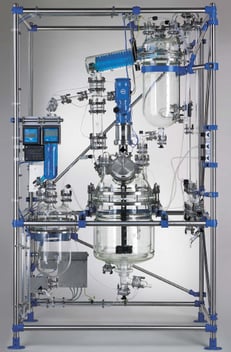Bridging the Gap Between Development and Piloting with Jacketed Reactors
 Traditionally, manufacturing processes are initially developed in round-bottomed laboratory flasks and are then transitioned to small-scale production-type reactors once the process is ready for piloting. QVF laboratory-scale jacketed glass reactors (also referred to as “miniplant reactors”) offer a unique alternative that features a vessel more similar in design and function to production-size reactors. In this post we’ll discuss the five main advantages of utilizing glass-jacketed reactors for development to scale-up testing and how they could potentially benefit your company.
Traditionally, manufacturing processes are initially developed in round-bottomed laboratory flasks and are then transitioned to small-scale production-type reactors once the process is ready for piloting. QVF laboratory-scale jacketed glass reactors (also referred to as “miniplant reactors”) offer a unique alternative that features a vessel more similar in design and function to production-size reactors. In this post we’ll discuss the five main advantages of utilizing glass-jacketed reactors for development to scale-up testing and how they could potentially benefit your company.
Obtaining Data
Through the use of the lab reactors, combined with process analytics, it’s feasible to collect a broad range of data on your processes even at the earliest of stages. The data provides a good understanding of the parameters for each process (e.g. temperature limitations, reaction time) that can be used to support process modifications.
Since you are able to create a miniature system that is almost identical to the full production layout, the majority of testing can be completed in the development stage. By the time you get to pilot testing only minor tweaks should need to be made to the process.
The collection of data also enables you to develop GMP (Good Manufacturing Practice), clean-in-place and cleaning verification procedures as a process is scaled up.
Identifying Problems
Jacketed lab reactors can also help to reveal problems in the early stages of process development. Since the geometry is that of a larger reactor, you can detect agitation issues that may not present themselves if mixing is done in a flask. Additionally, you can also model your process to use real heating and cooling times to get a more realistic demonstration of the process on a small scale.
Phase separations can create problems when a process is stepped up from a flask to a pilot reactor. But by using a miniplant reactor, you can mimic the phase separation that takes place in pilot and production equipment, eliminating this common scale-up issue.
Improving Safety
Another advantage of using a jacketed lab reactor is improving the safety of your process. Product is removed from a lab reactor through a valve in the bottom of the vessel, whereas a flask is usually emptied by picking it up, which can be dangerous should the reaction run out of control. Since you are going into the next stage with more data under your belt, it also reduces the risk of safety issues arising when you are progressing to the piloting phase. There isn’t the same element of uncertainty that comes along with upgrading from a flask to a reactor.
Saving Money
Miniplant reactors are a perfect example to illustrate how sometimes you have to spend money to make money. It’s no secret that jacketed lab reactor systems are significantly more expensive than the traditional lab flasks that are more commonly used at this stage of development. Depending on the size and scope of your R&D projects, you could be spending hundreds of thousands of dollars on equipment. That figure alone might be enough to put the brakes on a project. However, to see the full picture, you must consider the time that you can save in the development process (after all, time and money go hand in hand). When combined with the value of the product you are manufacturing, the ability to send a product to market sooner can substantially help your ROI. Consider a high value pharmaceutical product that pulls in revenues of $1 billion/year (or $3 million/day) - getting that product to market faster can have a huge (and positive) effect on your bottom line. Suddenly the value of the system doesn’t seem so outrageous when you consider the millions of dollars you have to gain by getting critical information early in the development of a process.
Saving Time
We’ve already alluded to how saving time can earn you money faster. But how exactly do jacketed lab reactors save time? This equipment is significantly more robust than laboratory flasks. The ability to gauge and control the reaction in the development stage eliminates any unpleasant surprises that can occur when testing a process in a pilot reactor for the first time (which can often lead to having to go back and redevelop a process). With the jacketed reactors utilized in the development phase, you can identify potential problems early and solve them before you get to the pilot stage.
Miniplant reactors also eliminate the need for reaction calorimeters which is a huge time saver. Reaction calorimetry is a practice often used to support intermediate scale-up where you measure the energy released/absorbed by the reaction. This process can take days between running the test and evaluating the data. But with the data already provided by the jacketed reactors, reaction calorimetry becomes unnecessary. Just think – if you were to do 100 risk assessments per year and each one took 2 days that’s about 200 days of work saved by not having to use a reaction calorimeter in the development cycle!
Miniplant Reactor Features
While the miniplant reactors are fully customizable to meet your testing requirements, the typical arrangement includes glassware that is installed above it featuring a manual valve to allow either reflux or removal of distillate. Product is removed through a valve at the bottom of the vessel (usually a manual valve on smaller reactors and a pneumatically operated valve on units greater than 20 liters). The design of the valve minimizes dead space and makes for a free flow of product through the valve, so that the product can be completely evacuated.
The following pictures are an example of a jacketed lab reactor systems installed at a customer site:

Figure 1: A 2-L jacketed lab reactor (JLR) with a dosing bottle on a scale at left.

Figure 2: A 2-L reactor with associated vapor trap (right) and distillate receiver (the glass ball). An insitu IR probe is inserted into the vessel on the left via a glass adapter (blue cap).

Figure 3: A scientist drains product from the manual bottom valve of a 2-L JLR.
Figure 4: A pair of 50-L, glass-lined steel JLR's with shared overhead glassware.

Figure 5: A pair of 20-L JLR's with shared overhead glassware.
Figure 6: Close-up of a 20-L JLR with a glass-lined, retreat curve (similar to production vessels) and a pneumatically operated bottom valve.
Just as a pilot plant is a scaled-down version of production equipment, QVF jacketed reactors make it possible for lab reactors to mimic pilot plant vessels. Using equipment that functions the same at both the development and pilot stages makes for a smooth transition in the scale-up of a process.
The advantages of using miniplant reactors in the development stage – obtaining data, identifying problems, improving safety, saving time and money – all work hand in hand to provide an optimized solution for product experimentation and scale-up testing. The ability to obtain information early in the development stage regarding how the process will work in production helps you make smarter, safer decisions while taking the guesswork out of pilot plant and full-scale production operations. Furthermore, this enables a company to get a drug (or other product) to market faster, which more than justifies the cost of the equipment. The end result is overall process optimization that promotes safe and efficient scale-up.
Some information in this post was taken from the Pharma magazine article that featured De Dietrich Process Systems.

